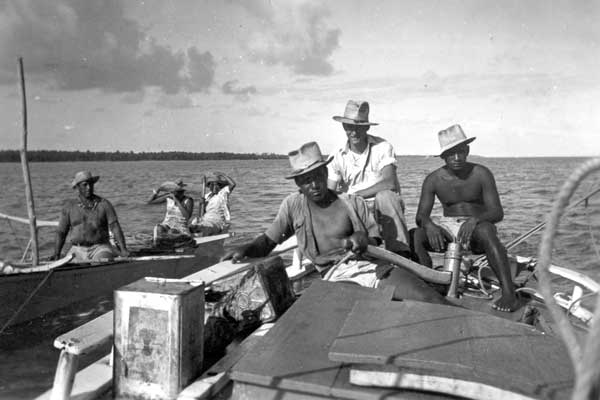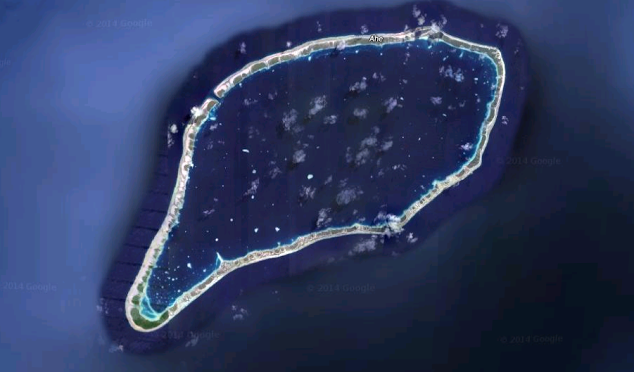History of Tahitian Black Pearls
 Photo from the Missionary Journal of O. Rudeen Allred, 1938
Photo from the Missionary Journal of O. Rudeen Allred, 1938
Long before pearls were farmed in the Tuamotu Atolls, the lagoons were fished for valuable mother of pearl from the black-lip oyster Pinctada Margaritifera - and to a lesser extent, the oyster's rare but highly valuable pearls. The shiny inner shells of these near-round, flat mollusks spreads from an iridescent white to a glowing rainbow at the rim, often glistening with greens, purples and golds and ending in mat black. Traditionally, this pearly part of the shell (called nacre or mother of pearl) was used for jewelry and fishhooks but when Europeans discovered the bounty they began collecting the shells en masse to make buttons and inlay for furniture and accessories.

The economy of the Tuamotu Archipelago was largely based on these exports from the early 1800s resulting in many disputes between islanders, the colonial powers and wily entrepreneurs who pillaged the natural oyster stocks and used the locals as cheap labor. Traders' logs admit bullying islanders into diving to dangerous depths for extended periods till the islander's ears ached, noses bled and brain damage was caused; loss of life was common. The trade brought outside goods and commerce to the atolls and many local divers, unaccustomed to money, bought canned food, cigarettes and clothes on credit. These same locals also collected oysters on their own and harvested pearls but often ended up selling them at lower than market value in order to pay off their debts. Through the centuries, the Paumotu culture had been based on sharing and money never did them much good.
By the 1950s the oyster stocks of the Tuamotus were severely depleted. Oyster collecting waned while copra (for coconut oil) and fishing became more important for the atoll economy. Recognizing that a resource was dying, investing in pearl farming began from the 1960s although the technology was crude. Besides being good for the economy, this encouraged people to raise the endangered oysters rather than harvest them. It wasn't until the mid-1970s that pearl farming began to attract big players.
The first was Jean-Claude Brouillet, in association with New York gem dealer Salvador Assael, who together purchased the Tuamotu atoll of Marutea Sud in 1975. Brouillet brought in the first pearl grafting technicians from Japan. These Japanese technicians knew how to perform the surgery, or "graft," used to insert shell nuclei into the small, Japanese Akoya oyster in order to create "cultured" pearls. A lentil-sized piece of tissue from the mantle - the organ of an oyster that secretes mother of pearl - is placed next to the nucleus and this produces a reaction, much like a skin graft, whereby mother of pearl begins to grow around the shell nucleus. Soon after arrival, the Japanese technicians created modified grafting techniques to work with the larger and more sensitive Pinctada Margaritifera native to the Tuamotus. At this time Tahitian black pearls were nearly unknown in the jewelry industry, were extremely rare and could fetch hundreds of thousands of dollars for a simple, single strand.
In 1984 an ambitious local Polynesian of Chinese heritage, Robert Wan, bought Marutea Sud from Brouillet and upped its production. He also began opening other farms throughout French Polynesia and by 1996 his production had surpassed one million pearls. Meanwhile other farms were opening, some on a commercial scale and others run by local families hoping to make their fortunes. Those residents of the Tuamotus not farming pearls were usually raising oysters to sell to pearl farms. Just a few years before, the islanders had been subsistence fishing but now, there was a gold rush at their doorstep. Everybody wanted in.
The Kamoka farmhouse was built by Patrick Humbert and his eldest son Loic Humbert in 1991 and it was the third pearl farm built on Ahe. Loic moved back to the US in 1992 after the laborious construction work was done and his brother Josh moved out to Ahe.
In the beginning the farm raised and sold oysters to other farms, mostly on the neighboring atoll of Manihi, until it had enough money to hire a grafter. The first person to graft at Kamoka was not a Japanese technician but a new local guy on the scene named Tevai - it was 1993. A grafter's fee was around US$3 per oyster plus food, lodging and all transportation, so it was far more cost efficient for a fledgling farm to hire someone nearby.
When Josh moved to Ahe the first thing he noticed about the family business was that grafting costs were preventing the farm from making pearls. Every oyster that was sold to another farm could be worth much more with a pearl in it. He had grown up half in French Polynesia with his dad (the other half the time he'd been in the US with his mom), studied Marine Biology for two years at college in California and was fascinated by oysters. He's said he had a dream as a kid where he was staring into the darkness of an open oyster (which is how a grafter spends his or her day) but he never realized what it was about until he began working with black lips. So Josh figured it was his destiny to learn how to graft.
Luckily, Josh was a very social guy and more than anything he loved to fish. So he began taking Japanese grafters from Ahe's other, richer farms, out fishing. Soon, between catching sashimi-quality tuna and fat grouper, the grafters began giving Josh hints and secrets to their highly guarded art. Josh talked his dad into letting him try to graft some of the farm's oysters and at first it was a disaster, or as Patrick calls it "a massacre," but Josh had his fishing buddies to talk to about his errors and soon he had figured out what he had done wrong.
One of Kamoka's oyster clients on Manihi was already making a fortune. The manager liked Josh's youthful motivation and gave him a set of professional grafting tools worth around $800 to help him get started in the trade. With the right equipment and a head full of secrets, Josh put his tunnel vision towards making perfect pearls. Before long his results were producing top quality pearls and other farms wanted to hire him. But he belonged to Kamoka and Kamoka was where he stayed. He went on to pioneer many sustainable pearl farming practices that continue to make Kamoka Pearl the leader in eco- and socio-responsible produced pearls that it is today.

